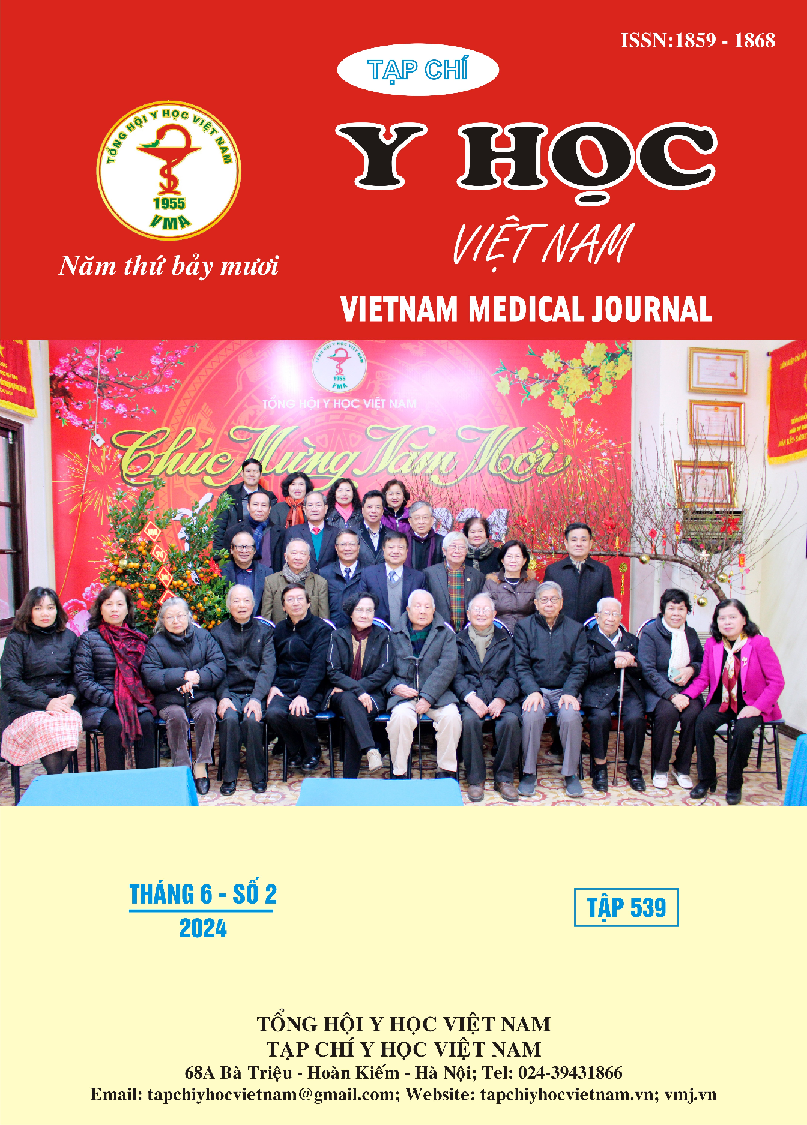CLINICAL AND LABORATORY CHARACTERISTICS, AND PACING PARAMETERS OF PATIENTS WITH THIRD-DEGREE ATRIOVENTRICULAR BLOCK IMPLANTED WITH DUAL CHAMBER PACEMAKER AT VIETNAM-SWEDEN-UONG BI HOSPITAL
Main Article Content
Abstract
A cross-sectional study on 60 patients with third-degree atrioventricular block implanted with dual-chamber permanent pacemakers at Vietnam-Sweden-Uong Bi Hospital, with the objective: “To describe some clinical, laboratory characteristics and pacing parameters of patients with third-degree atrioventricular block, implanted with dual chamber pacemarker at Vietnam-Sweden-Uong Bi Hospital”. Results: The mean age was 71,35±15,53 years old with 62% female. The most common comorbidity was hypertension (39 individuals), the most common symptoms were fatigue (78.33%), dizziness (31.67%); mean ventricular rate 43,95±12,25; 100% with narrow QRS; Right ventricular pacing threshold: 0.79±0.40, resistance voltage: 704.06±207.78W, sensing: 11.32±5.36 mV; Atrial pacing threshold: 1.06±0.39, resistance voltage: 572.63±161.59W, sensing: 3.81±2.58 mV. Conclusion: The clinical and laboratory characteristics of patients with third-degree atrioventricular block implanted with dual-chamber pacemakers at Vietnam-Sweden-Uong Bi hospital were quite similar to many other studies in Vietnam and around the world. Pacing parameters after implantation show that the hospital's pacemaker implantation technique initially achieved good results
Article Details
Keywords
dual chamber pacemaker implantation, atrioventricular block, Vietnam Sweden Hospital Uong Bi.
References
2. Trần Văn Đồng, Lê Văn Tuấn. Cấy máy tạo nhịp tim. Tim mạch can thiệp. Nhà xuất bản y học. 2022:Tr 1391.
3. Iwańska K, Gworys P, Gawor Z. Prognostic value of NT-proBNP levels in patients undergoing permanent pacemaker implantation. Pol Arch Med Wewn. 2010;120(4):120-126.
4. Vaturi M, Kusniec J, Shapira Y, et al. Right ventricular pacing increases tricuspid regurgitation grade regardless of the mechanical interference to the valve by the electrode. Eur J Echocardiogr. 2010;11(6):550-553. doi:10.1093/ejechocard/jeq018
5. Lin G, Nishimura RA, Connolly HM, Dearani JA, Sundt TM, Hayes DL. Severe symptomatic tricuspid valve regurgitation due to permanent pacemaker or implantable cardioverter-defibrillator leads. Journal of the American College of Cardiology. 2005;45(10):1672-1675. doi: 10.1016/j. jacc. 2005.02.037
6. Tạ Tiến Phước. Investigate the Techniques and the Hemodynamic Changing of Pacemaker Implantation. The Thesis of PhD Degree Graduation. 103 Military Medicine University; 2005.
7. Phạm Như Hùng, Trần Quang Việt. Ảnh Hưởng Của NT-Pro BNP Lên Ngưỡng Tạo Nhịp ở NB Suy Nút Xoang Được Cấy Máy Tạo Nhịp 2 Buồng. Tạp chí Phẫu thuật Tim mạch và Lồng ngực Việt Nam số Đặc biệt-Tháng 12/2021; 2008.
8. Thắng ĐC, Sơn - NL, Anh MX. Nghiên cứu đặc điểm lâm sàng, cận lâm sàng ở bệnh nhân trước và sau đặt máy tạo nhịp vĩnh viễn hai buồng tại Bệnh viện Trung ương Huế. TC Tim mạch học VN. 2021;(98):74-82. doi:10.58354/jvc.98.2021.97
9. Psychari SN, Apostolou TS, Iliodromitis EK, Charalampopoulos A, Kremastinos DT. DDDR pacing results in left ventricular asynchrony with preservation of ejection fraction and NT-proBNP: A prospective study in sick sinus syndrome and normal ventricular function. International Journal of Cardiology. 2010;144(2):310-312. doi:10. 1016/j. ijcard.2009.03.017


